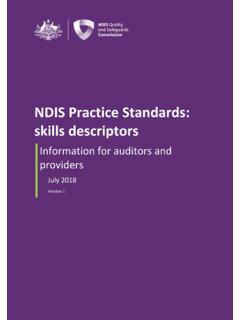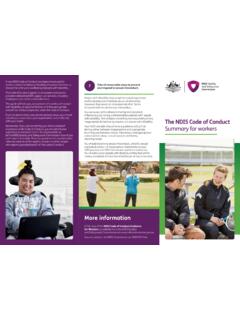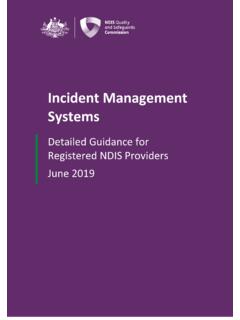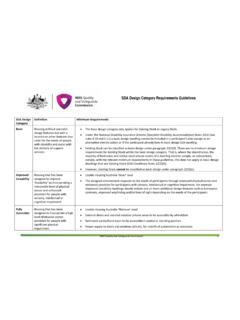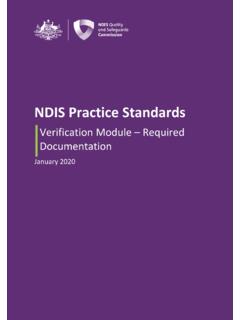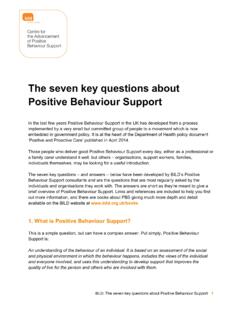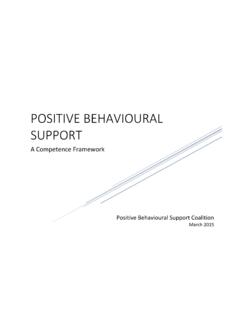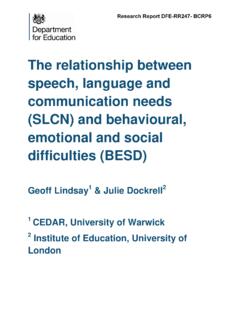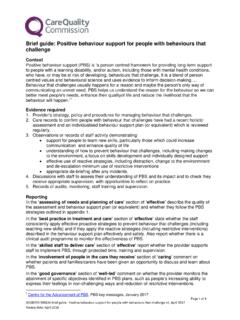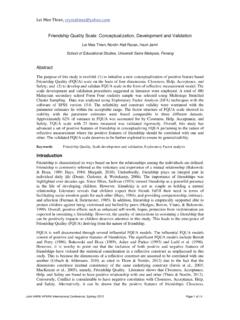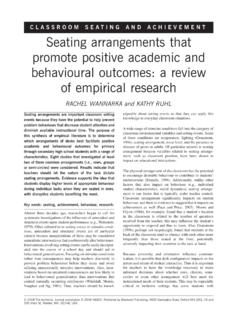Transcription of Compendium of Resources for Positive Behaviour Support
1 Compendium of Resources for Positive Behaviour Support A guide for Behaviour Support practitioners March 2019. This Compendium of Resources has been developed by the NDIS Quality and Safeguards Commission. Version 1, March 2019. Suggested citation: NDIS Quality and Safeguards Commission. (2019). Compendium of Resources for Positive Behaviour Support . Penrith, Australia: NDIS Quality and Safeguards Commission. NDIS Quality and Safeguards Commission 2. Table of Contents Glossary of Psychometric Terms .. 8. Introduction .. 10. Part 1 - Positive Behaviour Support Measures and Tools .. 12. A .. 18. ABC-2: Aberrant Behaviour Checklist .. 18. APS: Abbey Pain Scale .. 20. ABAS-3: Adaptive Behaviour Assessment System .. 22. ABCL/ASR: Adult Behaviour Checklist .. 24. A-SHARP: Adult Scale of Hostility and Aggression: 25. ACA: Affective Communication Assessment .. 27. ADAMS: Anxiety, Depression and Mood Scale .. 29. ADD: Assessment of Dual Diagnosis .. 31. ARMIDILO-S: Assessment of Risk and Manageability of Individuals with Developmental and Intellectual Limitations Who Offend - Sexually.
2 33. APAR: Assessment of Phonological Awareness and Reading .. 35. ADI-R: Autism Diagnostic Interview - Revised .. 37. ADOS-2: Autism Diagnostic Observation Schedule .. 39. ASIEP-3: Autism Screening Instrument for Education Planning .. 40. ASD-A: Autism Spectrum Disorders - Adult Version .. 42. ASD-C: Autism Spectrum Disorders - Children Version .. 44. B .. 47. BAI: Beck Anxiety Inventory .. 47. BDI-II: Beck Depression Inventory-II .. 49. BFRS-R: Behaviour Flexibility Rating Scale .. 51. BAG: Behaviour Assessment Guide .. 52. BPI-01: Behaviour Problems Inventory .. 53. BIP-QEII: Behaviour Intervention Plan Quality Evaluation, Version II .. 55. C .. 57. CANDID: Camberwell Assessment of Needs for Adults with Developmental and Intellectual 57. CDC: Carer Depression Checklist .. 58. ChA PAS: Child and Adolescent Psychiatric Assessment Schedule .. 60. CARS2: Childhood Autism Rating 62. CDI 2: Children's Depression Inventory 2 .. 64. NDIS Quality and Safeguards Commission 3.
3 C-SHARP: Children's Scale of Hostility and Aggression: Reactive/Proactive .. 66. CQ: Choice Questionnaire .. 67. CELF-5: Clinical Evaluation of Language Fundamentals .. 69. CMAI: Cohen-Mansfield Agitation 71. CM: Communication Matrix .. 73. CAS: Contextual Assessment Scale .. 75. D .. 76. DBC2: Developmental Behaviour Checklist 2 .. 76. DASH-II: Diagnostic Assessment for the Severely Handicapped-II .. 78. DRAMS: Diagnostic Risk Assessment and Management System .. 80. DisDAT: Disability Distress Assessment Tool .. 82. DISABKIDS .. 83. 85. EPS: Emotional Problems 85. ERCBS: Emotional Reactions to Challenging Behaviours Scale .. 88. F .. 89. FQLS: Family Quality of Life Scale .. 89. FQLS-2006: Family Quality of Life Survey-2006 .. 91. FSAMR: Fear Survey for Adults with Mental Retardation .. 93. FAST: Functional Analysis Screening Tool .. 95. FACT: Functional Assessment for multiple CausaliTy .. 97. FAI: Functional Assessment Interview .. 99. FCP-R: Functional Communication Profile - Revised.
4 101. G .. 103. G-DSDS: Gedye Dementia Scale for Down Syndrome .. 103. GSNQ: General Sexual Knowledge Questionnaire .. 104. GAS-ID: Glasgow Anxiety Scale for People with an Intellectual 105. GDS-LD: Glasgow Depression Scale for people with a Learning Disability .. 106. GFS: Goodness of Fit Survey .. 107. H .. 108. HCR-20V3: Historical Clinical Risk Management-20, Version 3 .. 108. HADS: Hospital Anxiety and Depression 111. 113. ILS: Independent Living Scales .. 113. I-CAN: Instrument for Classification and Support Needs .. 114. NDIS Quality and Safeguards Commission 4. ICAP: Inventory for Client and Agency Planning .. 116. K .. 118. KINDL 118. L .. 120. LSS-1: Life Satisfaction Scale-1 .. 120. LSS-2: Lifestyle Satisfaction Scale-2 .. 121. M .. 122. M-ABCS: Modified Abel-Becker Cognition Scale .. 122. MASS: Mood and Anxiety Semi-Structured Interview .. 124. MIPQ: Mood, Interest and Pleasure Questionnaire .. 125. MPAS: Moss Psychiatric Assessment Schedules.
5 126. MAS: Motivation Assessment Scale .. 129. N .. 131. NRDLS- 4: New Reynell Developmental Language 131. NCBRF: Nisonger Child Behaviour Rating Form .. 133. O .. 134. O&IS-R: Outcomes and Impact Scale-Revised .. 134. OBS: Overt Behaviour Scale .. 136. P .. 138. PPP: Paediatric Pain 138. PWI-ID: Personal Well-Being Index- Intellectual Disability .. 140. PPEC- C: Pragmatic Profile of Everyday Communication - 142. PPEC-A: Pragmatic Profile of Everyday Communication - Adults .. 143. ProQoL: Professional Quality of Life .. 145. PIMRA: Psychopathology Instrument for Mentally Retarded Adults .. 146. Q .. 148. QABF: Questions about Behavioural Function .. 148. R .. 150. Reiss Screen: Reiss Screen for Maladaptive Behaviour .. 150. RBS-R: Repetitive Behaviour Scale-Revised .. 152. RASSOR: Rapid Risk Assessment for Sex Offence Recidivism .. 154. S .. 156. SIB-R: Scales of Independent Behaviour - Revised .. 156. SBS: Sensory Behaviour Schedule .. 158. SNI: Social Networks 160.
6 NDIS Quality and Safeguards Commission 5. SPSS: Social Performance Survey Schedule .. 161. SSKAT-R: Socio-Sexual Knowledge and Attitudes Test- 163. Static-99 .. 165. SDQ: Strengths and Difficulties Questionnaire .. 167. SSS: Stress Survey Schedule .. 169. SIS: Supports Intensity Scale .. 171. 173. TACL-4: Test of Auditory Comprehension of Language .. 173. TSCC: Trauma Symptom Checklist for Children .. 175. TSCYC: Trauma Symptom Checklist for Young Children .. 177. Triple C: Checklist of Communicative Competencies .. 179. V .. 181. Vineland-III: Vineland Adaptive Behaviour 181. W .. 183. WHIM: Wessex Head Injury Matrix .. 183. Part 2 Relevant Internet Resources .. 185. Autism Awareness Australia (AUS) .. 185. Autism Victoria (AUS) .. 185. Alzheimer's Society (UK) .. 185. Association for Positive Behaviour Support (US) .. 186. Association for Science in Autism Treatment (US) .. 186. Australian Psychological Society (AUS) .. 186. Brainlink (AUS) .. 186.
7 Bridging Project (AUS).. 187. British Institute of Learning Disabilities (UK) .. 187. British Psychological Society (UK) .. 187. Centre for Disability Studies, University of Sydney (AUS) .. 187. Centre for Developmental Disability Health (AUS) .. 188. Challenging Behaviour Foundation (UK) .. 188. Child Mind Institute (US) .. 188. Health in Wales (UK) .. 188. Institute of Applied Behaviour Analysis (US) .. 189. Kansas Institute for Positive Behaviour Support (US).. 189. National Autistic Society (UK) .. 189. National Institute for Health and Clinical Excellence (UK) .. 189. NDIS Quality and Safeguards Commission 6. Office of Professional Practice, Health and Human Services Victoria (AUS) .. 190. Positive Behavioural Intervention & Supports (US) .. 190. Positive Partnerships (AUS) .. 190. Royal College of Psychiatrists (UK) .. 191. Scope (AUS).. 191. Scottish Government (UK) .. 191. Society for the Study of Behavioural Phenotypes (UK) .. 192. Therapeutic Guidelines (AUS).
8 192. NDIS Quality and Safeguards Commission 7. Glossary of Psychometric Terms Reliability Appraises the extent to which an assessment tool produces consistent and stable results. Internal consistency reliability Evaluates the consistency of each item within an assessment tool with all other items in the tool. Evaluated by calculating Cronbach's . FADOSor a test to have high internal consistency, should be > .80 although as low as .70 is acceptable. Test-retest reliability Assesses the extent to which scores on an assessment tool remain consistent across time. Correlation coefficients such as Pearson's r, kappa, and intraclass [ICC] are used to evaluate test- retest reliability, with r > .80, kappa .75 and ICC .75 commonly considered as acceptable. Inter-rater reliability Estimates test score consistency across multiple administrators of an assessment tool. Like test- retest reliability, correlation coefficients such as Pearson's r, kappa, and intraclass [ICC] are used to evaluate inter-rater reliability, with r >.
9 80, kappa .75 and ICC .75 commonly considered as acceptable. Validity Appraises the extent to which an assessment tool measures what it claims to measure. Face validity On face value, an assessment tool appears to be measuring its intended construct. Content validity Evaluates the extent to which items embedded within an assessment tool represent the construct being measured. This form of validity is usually established by verifying the link between theory and previous research by having experts assess the inclusiveness of the items, their accuracy, readability and appropriateness. Construct validity Construct validity is a judgement about whether the inferences drawn from an assessment tool are appropriate in terms of the construct being measured by the tool. Some strategies specifically linked to construct validity are factor analysis (to assess the underlying structure of the tool to check if the structure is theoretically expected), and evaluating test scores differences across naturally occurring groups ( , gender) and ensuring that the differences noted are theoretically expected.
10 Predictive validity Compares test scores from an assessment tool with scores from another tool taken some time after the initial administration. Predictive validity can be assessed by evaluating the percentage of NDIS Quality and Safeguards Commission 8. variance explained by the test scores for the predictor variable of interest, or the accuracy with which test scores correctly classify people into relevant groups. Concurrent (convergent) validity Compares test scores from an assessment tool with scores derived from another tool that assesses the same construct. This form of validity is typically assessed via Pearson's r correction, with r values > .30 considered acceptable. Discriminant (divergent) validity Compares test scores from an assessment tool with scores derived from another tool that does not assess the same construct. This form of validity is typically assessed via Pearson's r correction, with low, non-significant r values taken as evidence of discriminant validity.

